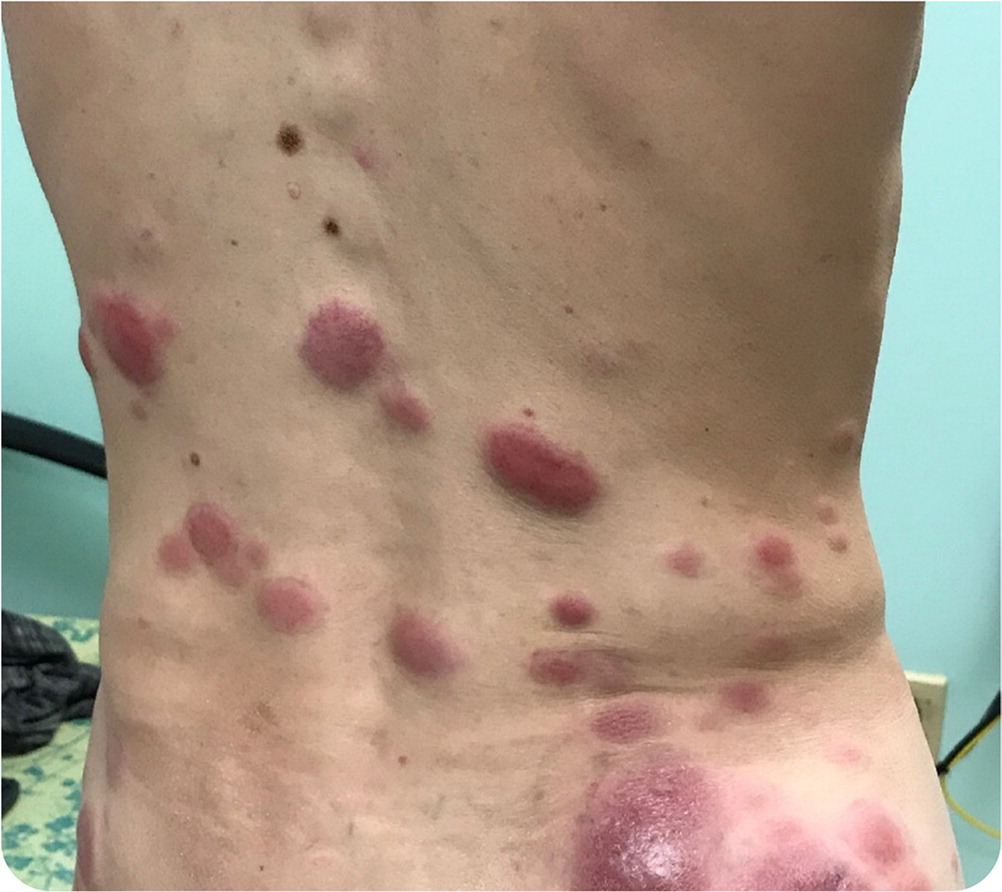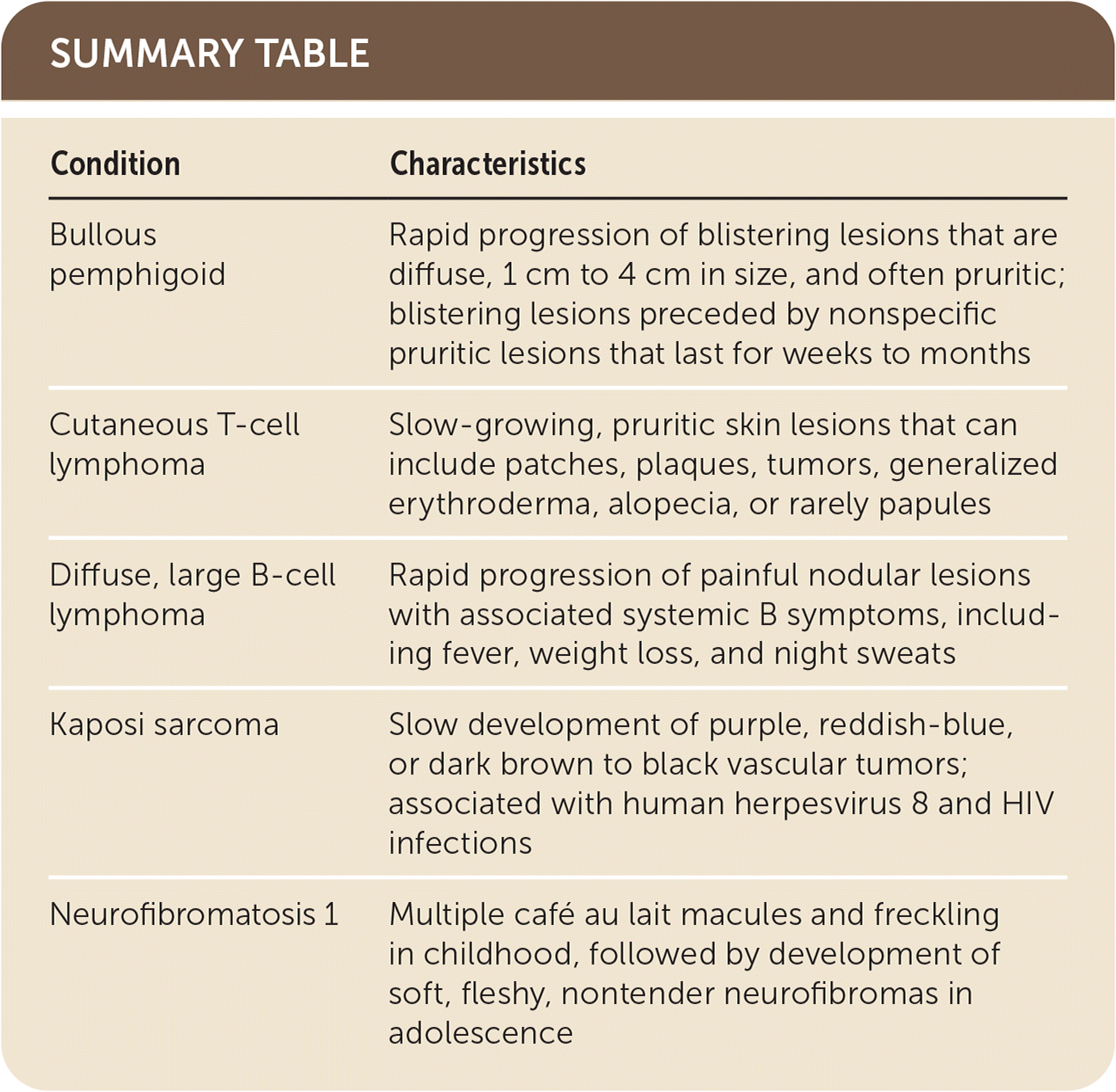
Am Fam Physician. 2022;105(5):547-552
Author disclosure: No relevant financial relationships.
A 40-year-old man presented with multiple skin lesions that developed three weeks earlier. He first noticed an erythematous, raised, painful nodule in his right axilla. Similar lesions appeared across his trunk, back, arms, and legs. He was initially evaluated in the emergency department and was treated with a steroid and a 10-day course of doxycycline, with no improvement.
The patient reported unintended weight loss over the previous several months, but he had no other systemic symptoms such as fever, chills, night sweats, nausea, abdominal pain, or myalgias. He was not sexually active and had no urinary symptoms. He had no recent travel or exposure to animals. His medical history was significant for multiple sclerosis, which was well controlled with fingolimod (Gilenya). The patient immigrated from eastern Europe nearly 15 years earlier and was current on all recommended immunizations.
On physical examination, his vital signs were normal. He appeared cachectic. The painful nodules ranged from 1 cm to 8 cm in diameter and were located diffusely in the axillae, upper arms, thighs, chest, abdomen, groin, and buttocks (Figure 1). The lesions were blanchable, and some had small blood vessels visible around the periphery. The lesions showed no fluctuance, induration, crusting, or drainage. No palpable lymphadenopathy was noted.

Question
Based on the patient's history and physical examination findings, which one of the following is the most likely diagnosis?
A. Bullous pemphigoid.
B. Cutaneous T-cell lymphoma.
C. Diffuse, large B-cell lymphoma.
D. Kaposisarcoma.
E. Neurofibromatosis 1.
Discussion
The answer is C: diffuse, large B-cell lymphoma. Punch biopsy confirmed the diagnosis, and the patient was referred for chemotherapy.
Diffuse, large B-cell lymphoma is the most common type of non-Hodgkin lymphoma in the United States. The median age at the time of diagnosis is the 60s and 70s. The condition is aggressive but responds well to treatment and is potentially curable.1,2 This patient had the typical presentation of rapidly enlarging, painful nodules and associated weight loss. Diffuse, large B-cell lymphoma is often associated with systemic B symptoms such as fever, weight loss, and night sweats. It is also associated with AIDS and the use of some immunomodulators, including fingolimod. B-cell and T-cell lymphomas can present with cutaneous manifestations before extracutaneous involvement.2,3
Bullous pemphigoid is an autoimmune disorder in older adults, involving rapid progression of blistering skin lesions that are diffuse, 1 cm to 4 cm in size, and often pruritic. They typically occur on the trunk, flexural surfaces, axillae, and inguinal folds, sometimes with mucosal involvement. The blistering lesions are preceded by a prodromal phase that can last weeks to months and often includes pruritic, eczematous, papular, or urticarial skin lesions.4
Cutaneous T-cell lymphoma typically presents with slow-growing skin lesions that can include patches, plaques, tumors, generalized erythroderma, alopecia, or rarely papules. Although lesions can develop anywhere on the body, the trunk is most common. Pruritus is the most common associated symptom and can be debilitating, often leading to the misdiagnosis of dermatitis. The peak age at presentation is 55 to 60 years, with a 2:1 male-to-female ratio.3
Kaposi sarcoma is an AIDS-defining vascular tumor characterized by purple, reddish-blue, or dark brown to black skin lesions typically on the legs, genitalia, face, or oral mucosa, possibly with visceral involvement. There are 10 different morphologic variants, including patches, plaques, and nodules. All four subtypes of Kaposi sarcoma are associated with human herpesvirus 8 infection, and the epidemic Kaposi sarcoma subtype is associated with HIV. Kaposi sarcoma typically has a chronic, indolent course, although it occasionally presents acutely.3
Neurofibromatosis 1 is characterized by multiple café au lait macules and freckling that typically appear in early childhood, followed by development of neurofibromas. Cutaneous neurofibromas are soft, fleshy, nontender tumors that usually appear in adolescence. Neurofibromatosis 1 can also be associated with osseous dysplasia, hypertension, and optic gliomas, typically occurring in early childhood.4

| Condition | Characteristics |
|---|---|
| Bullous pemphigoid | Rapid progression of blistering lesions that are diffuse, 1 cm to 4 cm in size, and often pruritic; blistering lesions preceded by nonspecific pruritic lesions that last for weeks to months |
| Cutaneous T-cell lymphoma | Slow-growing, pruritic skin lesions that can include patches, plaques, tumors, generalized erythroderma, alopecia, or rarely papules |
| Diffuse, large B-cell lymphoma | Rapid progression of painful nodular lesions with associated systemic B symptoms, including fever, weight loss, and night sweats |
| Kaposi sarcoma | Slow development of purple, reddish-blue, or dark brown to black vascular tumors; associated with human herpesvirus 8 and HIV infections |
| Neurofibromatosis 1 | Multiple café au lait macules and freckling in childhood, followed by development of soft, fleshy, nontender neurofibromas in adolescence |
